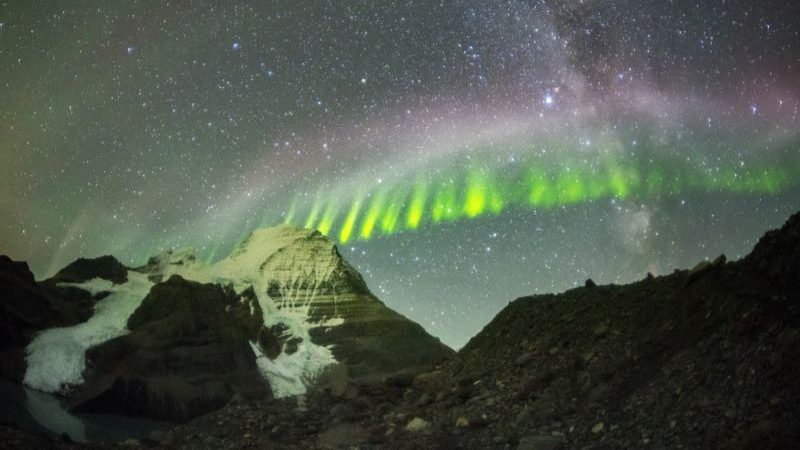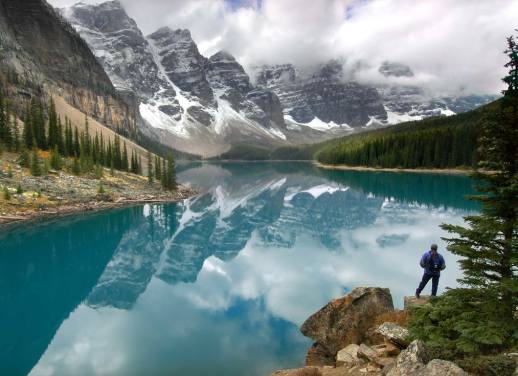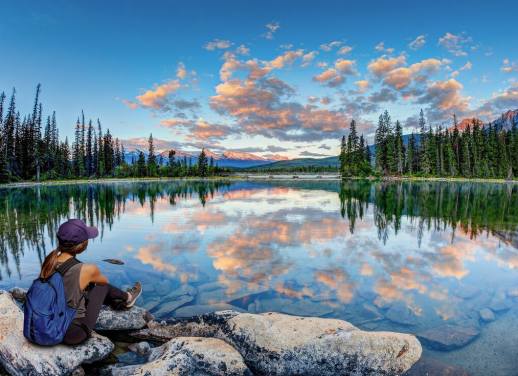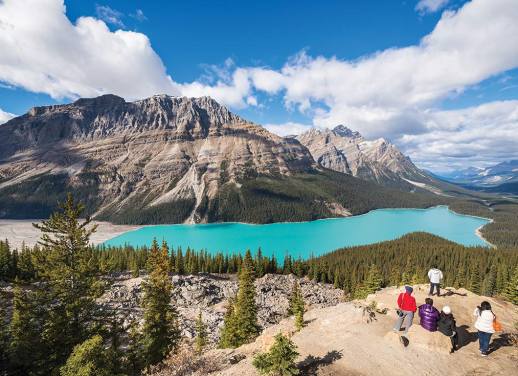When you think of the Northern Lights – the elusive green ribbons of the earth’s solar and magnetic fields that dance through the sky on dark cold nights – places like Iceland, Greenland, and the Norwegian or Canadian Arctic typically come to mind. We think far north, hence the name.
Sure, Iceland’s scenery is otherworldly, and its northerly latitude and longitude are perfectly positioned for viewing the Northern Lights, but the weather is unpredictable. In the winter months, when the aurora forecast is typically at its strongest, it’s often cloudy (and overcast, at best). And, well, the Arctic isn’t very accessible during those dark winter months – for most of us at least. Instead, we rely on researchers and scientists brave enough to spend winter there to share imagery of the aurora with us.
Much to my surprise (especially as a Canadian married to an Icelandic), some of the best places to spot the bright pallet of colours of the aurora are actually right here in my backyard. Alberta, Canada is home to the top two largest Dark Sky Preserves on earth: Wood Buffalo National Park (also Canada’s largest national park) covers an area of 44,807 km2, and Jasper National Park covers an area of 11,000 km². Those spots – and plenty of small towns and parks across the province – make Alberta one of the most spectacular places on earth to catch the aurora at its finest.
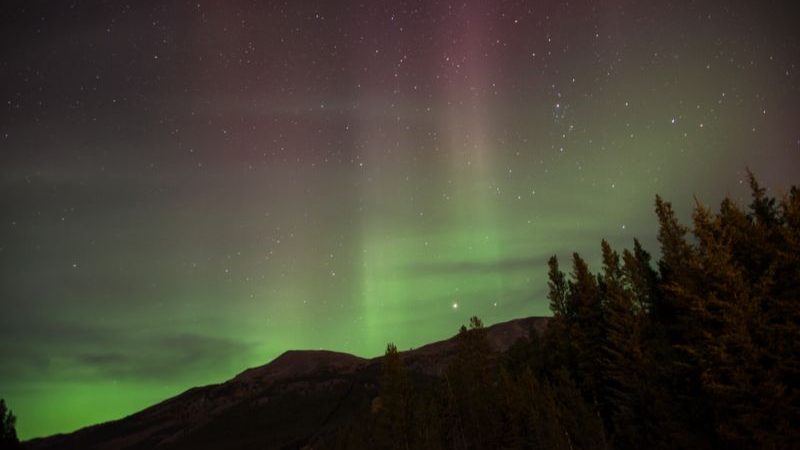
The Northern Lights, dancing above Banff. Photo by Janice Chen.
There are two things that set the search for the Northern Lights in Alberta’s Rocky Mountains apart from anywhere else: the pure, unobstructed solitude of Alberta’s dark skies, and the fact that the region gets more cloud-free days than most places on earth. Despite the incredibly harsh, cold winters, (seriously, Alberta has some of the coldest-ever temperatures recorded in the Canada, getting as low as -60°C) Alberta has clear skies more than 300 days per year, with Edmonton and Calgary ranked as the country’s sunniest cities.
If you’re up for stargazing and adventure in some of Canada’s most wild, extreme conditions, head to the Rockies during the winter to see some serious celestial magic on display. From the bustle of Edmonton, to the sprawling space of Peace River, to the untouched gem that makes up Jasper National Park and the unsurpassed rugged beauty of Banff, Canmore and Kananaskis, Alberta’s natural state – especially in the colder months – will captivate you.
EXPLORE OUR FULL RANGE OF SMALL GROUP ADVENTURES IN CANADA NOW
Jasper National Park
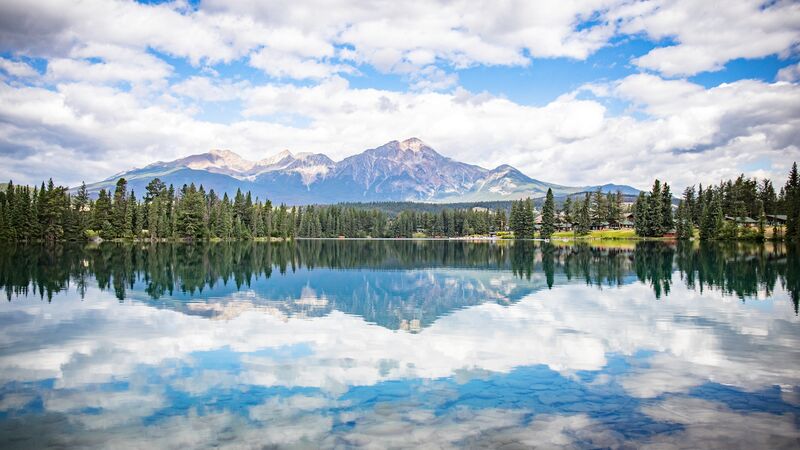
Perfect reflections in Jasper’s stunning Annette Lake. Photo by Liam Neal.
A true untouched gem in Alberta is UNESCO World Heritage Site Jasper National Park. Though there’s a historic, laid-back little town right in the centre of the park – created in 1907 along the Canadian Pacific Railway – it remains a remote wilderness because of its secluded location three hours from Lake Louise, four hours from Edmonton, and five hours from Calgary.
For stargazers and aurora hunters, the best thing about Jasper National Park is that in March 2011 it was designated as a Dark Sky Preserve by the Royal Astronomical Society of Canada. Receiving the designation requires the area to have little to no light pollution. “In Jasper, we changed the park lights to dark sky lights, with fixtures that shine downwards instead of upwards towards the sky,” says Rogier Gruys, who works for Parks Canada as a product development specialist. “We all need darkness. For ourselves to sleep, and for a lot of nocturnal animals, be it turtles, owls, wolves, bears, and bats, who all rely on darkness to hunt and live – so having natural dark skies is important.”
“In bright cities, you see insects attracted to the light, and of course that’s not natural. For wildlife everywhere, including here in the Rockies, it’s so important to have natural dark areas,” he says. Even humans benefit from the dark sky, adds Gruys. “When people sleep, scientists recommend a dark room, so if we’re using our phones with a lot of blue light, have streetlights or the neighbour’s lights shining into our windows, it disrupts our circadian rhythm, disturbs our natural patterns, and makes it more difficult to sleep – that’s why it’s important for us to have darkness.”
According to former marketing manager for the Fairmont Jasper Park Lodge Taylor Lancee, “We’re fully outnumbered in Jasper by elk, deer, moose, coyotes, wolf, black bears, brown bears, grizzly bears, foxes… the list goes on. But you definitely find more wildlife than people here.”
RELATED: 8 INCREDIBLE ANIMALS YOU’LL FIND IN CANADA
So bonus, you can come to the Rockies for not only the astronomy and wildlife, but for some much-needed REM sleep too. And if you don’t catch the Northern Lights, there is plenty to do in the charming old town, like visiting the delicious Jasper Brewing Company for a pint of their signature Jasper the Bear Lager (named after the town’s mascot), brewed with clover honey. Later, grab dinner at sinister-themed Evil Dave’s, where they served locally sourced Canadian cuisine with a wicked twist (the hell’s chicken is to die for). If you’re a skier, the local mountain, Marmot Basin, has more champagne powder than anywhere else in Canada, due to its altitude and dry climate, and no line ups longer than two minutes at the lifts; a true local secret.
Later, head to the Fairmont Jasper Park Lodge, situated on the shores of Lac Beauvert, and visit the planetarium. It’s a unique 50-person geodesic heated dome where you can learn about the aboriginal star history of the area. Afterwards, eat s’mores and drink hot chocolate or a cocktail, and take a peek through the two largest telescopes in the Rockies at the stars, nebulas, and craters on the moon; you’ll even be able to see the pink dust around the stars.
If you’re passionate about astronomy, plan your trip during the Dark Sky Festival (which happens this year from October 18-27 at the Jasper Park Lodge and Planetarium). You’ll rub shoulders with some astronomy greats, watch the sky while an orchestra plays, and learn more than you thought possible about the night sky.
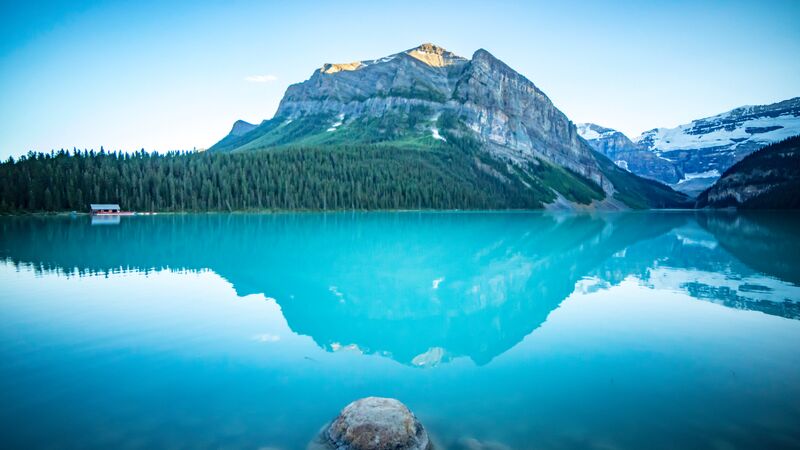
Banff’s incredible Lake Louise. Photo by Liam Neal.
Just 10 minutes from the town of Jasper is Pyramid Island, a local favourite place to stargaze. Walk 100 metres down an easy trail – so easy that you can’t get lost, even in the dark – then cross a small bridge that gives you a perfect view to the north. If there’s no moon, it’s likely you’ll see the Milky Way. During summer, Pyramid Island has incredible reflections, and in winter, the frozen lake surrounded by snow-covered mountains makes for a beautiful backdrop.
Another must during winter is the ice walk through the Maligne Canyon – and you can do it regardless of the hour. By day, pop on ice cleats and a helmet and explore the incredible karst cave and river system that runs beneath the deepest canyon in the Rockies, with 30-metre-high limestone walls, surrounded by glittering ice caves and towering frozen waterfalls that glow turquoise with the sun. You’ll notice patterns in the ice and snow that look like they can’t possibly be made naturally, and the tiniest, most intricate snowflakes and icicles, if you get up close. By night, you’ll be taking this all in with headlamps, then have a chance to flick them off and watch the sky in a place with no light pollution at all.
RELATED: WHY YOU SHOULD GO ON A CAMPING ADVENTURE THROUGH THE ROCKY MOUNTAINS
Icefields Parkway
The Icefields Parkway – a 232 km stretch of highway that winds through the Rocky Mountain peaks, icefields, waterfalls, and valleys from Jasper to Lake Louise – is rated as one of the best drives in the world. Not only that, if you drive it at night, it’s dark enough to catch a glimpse of the fabled aurora, where gaseous particles from the earth’s atmosphere collide with charged particles released from the sun’s atmosphere.
“There are maps of light pollution – even with towns 300 km away, it still has an effect – but with the Icefields Parkway, it is truly dark, with absolutely no light pollution,” says Gruys. “You get both the Northern Lights, and the incredible scenery with a mountain backdrop to go with it,” he adds. “And even if you don’t catch the Northern Lights, you can see fully moon-lit natural landscapes, the Milky Way, and many stars.”
RELATED: 10 ESSENTIAL WINTER ACTIVITIES TO TRY IN CANADA

The Northern Lights, dancing above Banff. Photo by Janice Chen.
Pull over at the Columbia Icefield – the largest fields of ice south of the Arctic Circle – and take in the views of the glaciers and sprawling ice. Stop at the weeping wall, where you’ll catch ice climbers in action during the winter; in summer, it resembles weeping tears towering down the side of the rock, hence the name.
Peace River
The Peace River is one of the least populated parts of Alberta, which means better Northern Light-viewing opportunities. It’s a true wide-open space – which is its biggest draw – where people come to get away from it all. Camping in spots like Lac Cardinal Recreational Area, George Lake, and along the Peace River are your best bets for finding solitude and the aurora. By day, you can snowshoe along the Peace River and Misery Mountain Ski Area, where you’ll find lots of snowshoe trails and, from the top, you can see the whole Peace River Valley. By night, the sky is yours to take in alone.
Don’t let the cold scare you off; that’s what winter parkas, fleece and Gore-Tex were invented for. Winter is the best time to see the Northern Lights, and for stargazing in general because it gets darker earlier; it means you don’t have to stay up too late in the freezing conditions to see them. Of course, it also depends on the activity of the sun; sometimes the lights will come out in full force, other times they’ll be weak, and every so often you won’t see them at all.
RELATED: 9 FOODS TO TRY ON YOUR CANADIAN ADVENTURE (THAT AREN’T POUTINE)
Tip: Learn how to take photos of the Northern Lights before you head off into the cold night. In -30 weather you don’t have any time to fiddle with your tripod and ISO. Get your camera set up as best as you can for a long exposure with a wide aperture to capture as much as you can. I highly recommend a camera remote, and a pair of camera-friendly gloves.
Canadian winter adventures are always followed up with warm open fires, hearty food (like poutine, bison, elk, and some of the best beef in the world), uniquely accommodation, camp spots with wild views and nobody else in sight, and warm-hearted, plaid-clad Canadian hospitality – you’re in for the trip of a lifetime.
Embrace Canada’s dark skies – and catch a glimpse of the elusive Northern Lights – on our 11-day Canadian Rockies & Northern Lights small group adventure.

